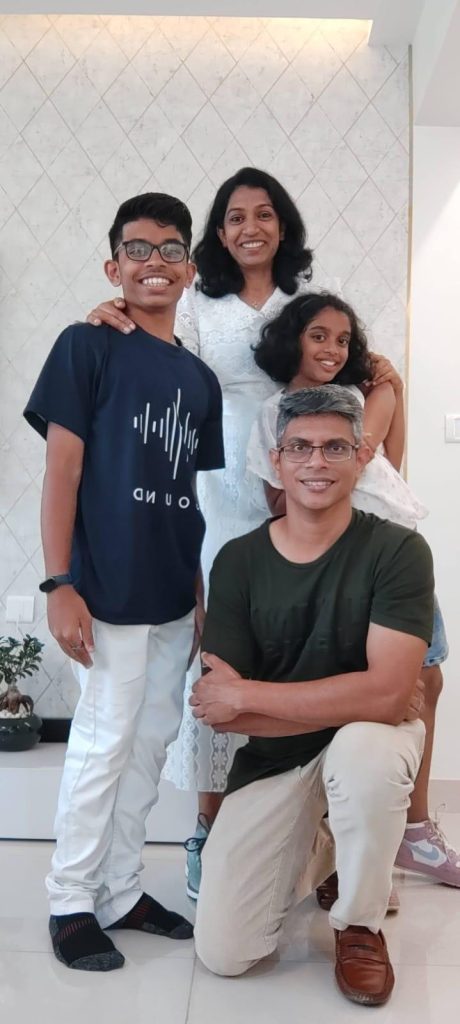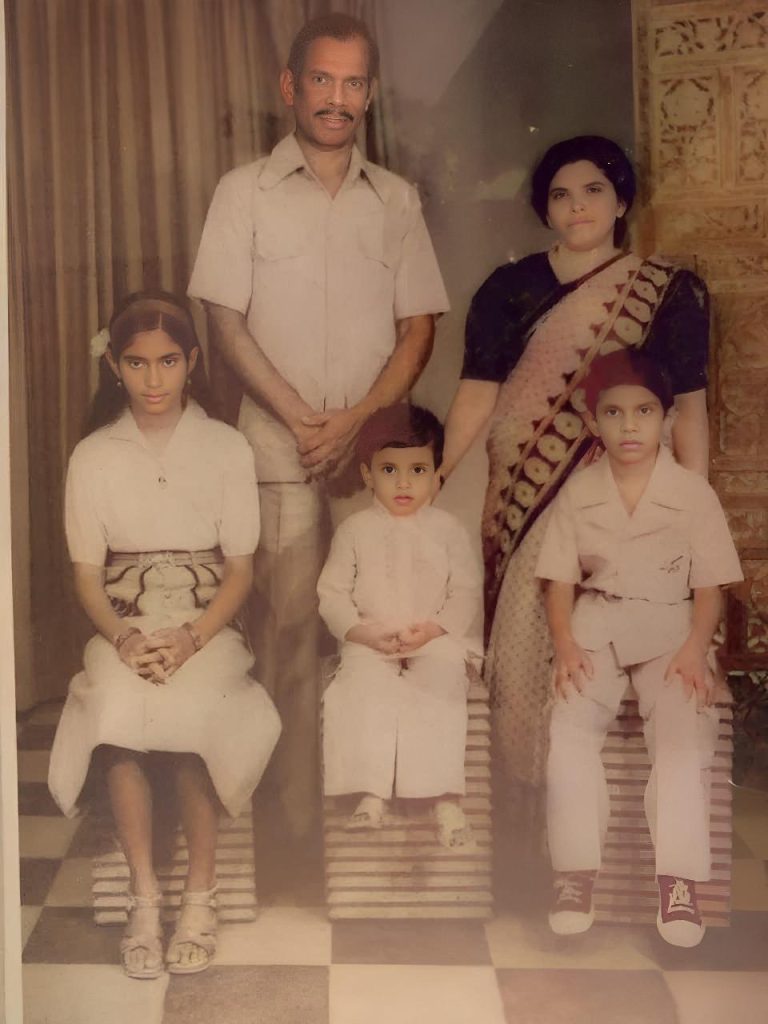For me since the moment I joined Nuvepro, Rajesh was the kind of guy you’d expect to meet at a high-stakes boardroom discussion or overseeing the meticulous engineering of Nuvepro Technologies. He’s tough—there’s no doubt about that. Ask anyone who’s worked with him, and they’ll tell you: that Rajesh’s daily standups years ago were legendary, some of the toughest sessions his team could sit through. But here’s the twist—ask Adarsh, a long-time colleague and a friend of Rajesh and he’ll tell you that Rajesh was 100x tougher back then. That was the Rajesh who demanded the best from everyone, didn’t settle for mediocrity, and pushed himself and his team relentlessly.
Today, though, there’s a gentler side to him. A softer version of the man who built the backbone of Nuvepro. But what’s remarkable is the journey from the tough, no-nonsense leader to this more reflective, yet still deeply focused individual. And believe me, this transition isn’t just about his wonderful grey hair—it’s about evolving, about seeing the world through new lenses without losing sight of the mission.
During an interview with him (Anisha and I had the pleasure of sitting down with him recently), we were taken aback by a side of Rajesh we didn’t expect—the kind of guy who, as a schoolboy, was the stuff of novels. The same guy who wrote poems in Malayalam, English, and Hindi, learned French, dabbled in drawing, and even indulged in wooden art at his house. Imagine that! He’s the kind of person you’d expect to read about in a book—one of those characters who is artistic, introspective, yet somehow destined for something more. It was almost like discovering a hidden chapter of Rajesh’s life that you wouldn’t expect from the tough, driven leader we know today.

Growing up in the picturesque city of Trivandrum, Kerala, Rajesh’s upbringing was defined by the hard work and discipline of his parents. His father worked with BEST in Mumbai, while his mother was part of the distinguished institutions BARC, Mumbai, and later at ISRO in Trivandrum. Rajesh, the middle child among three siblings, remembers a childhood rooted in education and the stability that his parents’ government jobs provided. But beyond that stability, there was a sense of adventure—a sense that Rajesh was destined for something more than the ordinary.
As a young boy, Rajesh harbored a dream of joining the defense forces, particularly the Navy. His passion was so strong that he even attempted the Sainik school exams but fate had other plans. He fondly remembers playing imaginative childhood war games with his friends in a defunct textile weaving factory, which served as their battleground. This childhood passion for defense was also influenced by his neighborhood friend Harshan R Nair, who later joined the defense forces. Rajesh so fondly remembers his friend Harshan that it is unfair to talk about Rajesh’s dreams without mentioning about Late Harshan R. Nair who was posthumously honored Ashoka Chakra. We melted when we heard the story and do drop by at Rajesh’s desk to hear it too. 🙂 While Rajesh’s military aspirations didn’t materialize, his spirit for adventure and vision for something greater did. The passion remained, morphing into something that would define his career—a drive to create, build, and lead.
Rajesh often reflects on his early years and how they shaped him. “I grew up in a world where books were my gateway to new cultures and ideas,” he told us. “I didn’t travel the world back then, but the stories in those books made me feel like I was already a part of it. I read everything—Malayalam, English, Hindi. Poetry was a way to express myself, but it wasn’t just about the words; it was the way my mind raced with possibilities.” The same boy who wrote poems would one day cofound Nuvepro. And while the poetry eventually faded, his creative spirit never left him. His house is a testament to that.

It was this same spirit that led Rajesh to his significant professional milestone: his time at Mindtree. There, he worked closely with Giridhar, Our CEO, and the account head for a major business with Symantec back then. Mindtree was a stable, established company, with clear career progression. But Giri saw something more. He saw potential in a product idea that could grow beyond Mindtree’s corporate structure.
Rajesh, always the man of conviction, recalls those early days: “Giri’s decision to leave Mindtree and pursue this product was a game-changer for me. It was no longer just about managing accounts; it was about creating something from scratch. I saw it as a rare opportunity—a chance to build something real, something bigger than any corporate ladder I could climb.”
Together with Umesh, Moyukh, and Giri, Rajesh made the leap into the world of product development. But it wasn’t just about making a new product. It was about building an entire vision. “We didn’t rush into it,” Rajesh reflects. “It was a gradual realization that what we were working on was more than just another project. We were creating something that deserved to stand on its own, outside of Mindtree. It was going to be bigger than us, and we knew it.”

The decision to take this plunge wasn’t easy, especially for someone like Rajesh, who had a clear career path in a well-established company. “I had a stable job, a clear future. Leaving that to pursue a startup was a huge leap. But my wife was my rock. She supported me every step of the way. We knew it was a risk, but we also knew that we had something special in our hands.”
Rajesh’s wife, a pillar of support through all the ups and downs, understood the importance of following his passion. “It wasn’t just about the money,” Rajesh shares. “It was about building something from the ground up. It was the chance to shape something that had never existed before. And that’s what made the decision worth it.”

In those early days, the team spent countless hours brainstorming and pivoting the product—figuring out how to transform it into something sellable, and scalable. “The late-night brainstorming sessions at Jani’s house were unforgettable,” Rajesh says with a smile. “We were all in it together, figuring out how to turn this idea into something real. And that’s how Nuvepro was born—not just as a product, or as a platform, or as a service, but as a solution that could change the way enterprises approached skilling in technology.”
Today, as Nuvepro celebrates its 10th anniversary, Rajesh is proud of the journey, the challenges, and the triumphs that have brought the company to where it is now. “It’s been a decade of learning, growing, and, most importantly, evolving,” he reflects. And yet, despite the softer version of Rajesh that has emerged, his core remains the same: a man driven by passion, vision, and an unyielding belief in the potential of his team. It’s the same spirit that led him to leave Mindtree, to take risks, and to build a company that has impacted the world of technology.

Of course, as a colleague, I would love to see the poetic side too, as a Marketing Person even more. As Adarsh, his colleague and friend, so eloquently puts it: “Rajesh is a very good person. You can talk to him about anything, and whatever topic it is, he has incredible clarity on it. He articulates ideas in a way that makes you see them from a new perspective. His insights always carry weight. Adarsh, known for his self-assuredness, admits that it’s not often he offers praise lightly. “I don’t usually appreciate people in that way. I tend to feel that I know pretty much everything and can handle things on my own,” he continues. “Even when I ask for advice, I don’t always take it as it is, but rather, I see it as an input. With Rajesh, though, his insights always carry weight. It’s that kind of clarity and wisdom that makes him stand out.”
Just some time back, while speaking with our Chairman, Mr. Janakiraman, he shared a thought that resonated deeply with me. He said, “Rajesh is exactly the kind of person that you, Moyukh, and Giridhar need.” I found myself nodding in agreement, having long thought of Rajesh as a perfect mirror—someone who reflects both strengths and weaknesses with equal clarity. Mr. Janakiraman was visibly struck by my words, and he remarked that my sentiments echoed his own feelings perfectly. He went on to say, “Rajesh is the kind of individual who doesn’t just accept things at face value. He questions everything, challenging assumptions with an understanding that sees beyond the black-and-white. It’s his ability to navigate the grey areas that sets him apart, making him an exceptional critic.”
To be a great critic, one must first be an acute observer, and Rajesh, with his sharp eye and nuanced perspective, has always exemplified that. As we discussed his evolution, I mentioned to Mr. Janakiraman how I believed Rajesh had perhaps softened with time. But Mr. Janakiraman, ever so candid, disagreed. “He better not have,” he said. “I like Rajesh just the way he is—tough, honest, and unyielding in his approach. From the young man who first joined us to the remarkable person he is today, he has been nothing short of wonderful.”
I also had the pleasure of speaking to Rajesh’s wife, Hima, who has a wonderful message for him. ‘’ Over the past 10 years, I’ve witnessed Rajesh’s growth alongside his company, always leading with dedication and vision. He approaches challenges with a calm and positive mindset, never allowing the pressures of work to affect our home life. His commitment to maintaining a healthy work-life balance is truly inspiring, and this harmony has been key to his success, both personally and professionally. Congratulations on this incredible milestone!’’
Thank you, Rajesh, this interview with you, for me, will always remain personal. I am sure, so many things not covered, and so many mentions not done, but this talk has not just scratched the surface for me, I take back a thing or two, and thank YOU for it.
Authored by – Shivpriya R. Sumbha | Editorial Reviewer – Anisha K Sreenivasan

